
by Grigoriy Zilberg and Richard Cryberg
Submitted June 28, 2007

Abstract: The Serpastie pigeon is one of the major domestic breeds developed in Ukraine. Its English breed name is Skycutter. This breed possesses a hyperflexible1 wrist joint that allows the end of the wing to swing forward at the wrist up to 30 degrees or more from the normal straight line. The breed flying normally will swing the end of the wing forward and can hover, drift sideways or climb vertically. The purpose of this study was to learn what structural modifications to the wing allow for this hyperflexabilty.
Introduction: The unique flight capabilities of the Skycutter make it an interesting domestic breed to study. As far as the two authors know the only breeds that have such flight capabilities are all closely related to the Skycutter and were all developed in the Ukraine. No other breed is known to have the hyperflexible wrist joint. Photos of Skycutters in hover clearly show this extra flex and it is believed to allow part of the flying performance they exhibit.
There are three common methods nature uses in joints to limit mobility. Many joints have bone projections that interfere with the mating bone surface2 such that the joint simply locks when opened fully. Elbow and upper ankle joints in a great many mammals use this method to prevent hyperextension. Strong ligaments bridge both sides of many joints and restrict lateral joint movement. The human knee is an excellent example. The famous ACL injury that athletes frequently suffer allows the knee to flex laterally inward. Joints are sometimes restricted from excessive flex by the strength and length of the muscle/tendon arrangements that are used to propel the joint in normal use. Leaning forward and touching your fingers to the floor is an example of muscle-tendon restriction.
To learn what gives the Skycutter its unusual flexibility, dissection studies were performed on Skycutter wings and compared to Homer wings.
Discussion: Below is a picture of a Skycutter extended wing. Pictures like this begged the question of how the bird has been structurally
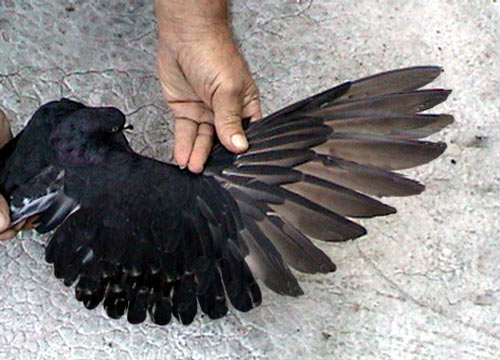
Picture 1: Intact Skycutter Wing.
modified to allow the greater then normal flex. In a normal pigeon if you take the wing and extend it the wrist joint locks when the wing is extended to a straight line. In the Skycutter the wrist joint bends forward from a straight line significantly before the joint locks. In both cases, this locking angle is easily felt and well defined. It seemed unlikely that loose ligament structures were responsible, particularly as the ligaments would not be the normal way for a joint to be locked in its rotational plane. Further, the Skycutter shows no evidence at all of any excessive wrist flexibility in the vertical plane parallel to the open wing. This would indicate that the ligaments were normal in function and length.
Dissection of wings3 from Homers and Skycutters were performed. To visualize the parts as they actually moved these dissections were done on untreated wings at normal living water levels. Complete wings on Homers were dissected starting with the coracoid and scapula and out to the distal end of the carpo-metacarpal. Each joint was dissected in order and when clean and dry glued back together in lifelike orientations with Paleo Bond4 cyanoacrylate adhesive.
In addition, as each joint was dissected the joint was moved in its normal plane of motion to understand how the various parts interacted during normal use. The motion of both ends of the humerus is quite complex as these joints not only open in a plane but also rotate during opening. Fortunately, no real difference was seen between the Homer and Skycutter in function of these two joints.

Picture 2. Homer and Skycutter Wing bones.
Picture 2 shows the bones of interest in both a Homer and Skycutter wing. The bones are mounted in modeling clay to hold them stable for photography. The clay is the off white putty like substance seen under the bones. These bones were color coded by painting them with acrylic paint that can be found at any hobby shop. The color code is as follows going from left to right in the above picture:
Purple – Humerus Purple - Ulnare
Yellow – Ulna Red – Carpo-Metacarpal
Natural – Radius Yellow - Phalanx
Green – Radiale
The bones in Picture 2 show the left wing from the top view. The bird would be flying from the top of the page towards the bottom of the page.
The distil end of the humerus attaches to both the radius and ulna. The radius and ulna slide in the axis of the wing relative to each other by about 4 mm in a Homer when the wing opens. The radius is displaced towards the pigeon’s body relative to the ulna during opening. This displacement is important, as without it the wrist would not be able to fully open to a straight line. Unlike the human arm the radius, radiale and ulna together with the various ligament attachments between these three bones and surrounding bones form a structure that will not twist in the axis of the wing.
The distil end of the radius is terminated before the main part of the load bearing joint by a small, modified wrist bone named the radiale. In a four-year-old Skycutter, the junction between the radius and radiale is essentially fused. In young Homers, this joint is still cartilaginous. In either case, it is not flexible. The outer distil end of the radiale terminates in a bony projection that in homers has a pronounced curvature and is relatively massive. In Skycutters this structure is much thinner.
The proximal end of the carpo-metacarpal consists of a normal looking cylinder shaped joint that rotates against the ulna-radiale female portion of the joint. This rotation happens only in the horizontal plane. Think of this joint as a tuna can with a stick coming out the side for the carpo-metacarpal bones. This sits inside part of a slightly larger can that has an arc of only 20% of the circumference. This large can is the distal end of the radiale and ulna. The top and bottom of the joint (the two flat ends on the cans) are bound together by extensive sheets of ligament between the bones on opposite sides of the joint. This ligament structure allows rotational movement in the joint but no flex in the vertical direction.
On the carpo-metacarpal, there is a bony projection that hits the top surface of the radiale when the wing is fully opened. In picture 2, this bone projection shows clearly just to the left of the phalanx. The bone projection interferes and prevents further opening. This bone projection is both larger and thicker in a Homer then in the Skycutter. As various ligaments bind the joint tightly together when this bone hits the side of the radiale the joint is prevented from opening further. Picture 3 shows the joints, as they would be orientated in life when fully extended for a Homer and a Skycutter.
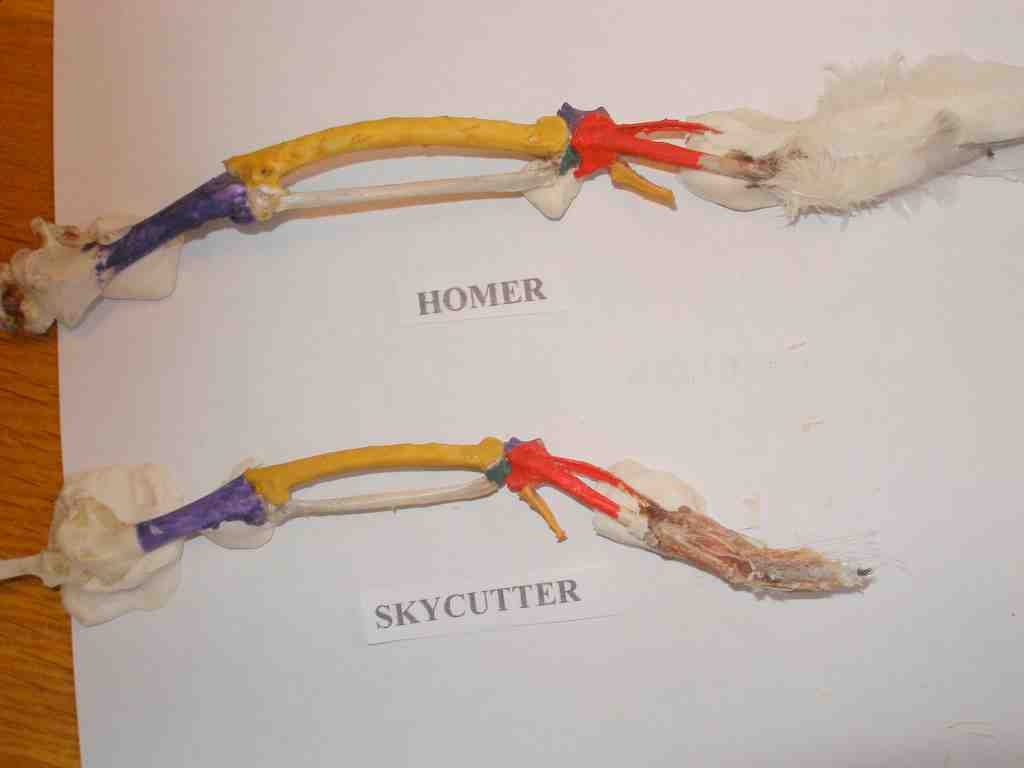
Picture 3. Homer and Skycutter wings fully extended and articulated.
X-ray photographs of un-dissected wings also confirmed these orientations. The x-ray photos clearly showed that when the wing was fully opened to the point that the joint felt locked from further opening that the bone projection on the carpo-metacarpal was indeed in contact with the radiale.
It is a lot less obvious how sensitive this whole mechanical system really is when looking at pictures versus looking at the bones in real life. In real life a bit of manipulation shows that tiny changes in the shape of the radiale and the mating bone projection on the carpo-metacarpal result in major changes in how far the joint will rotate forward from a straight line. As little as a one-millimeter change in the radiale shape is enough to allow an extra rotation of 30 degrees or more. Further, in picture 3 no allowance is made for the thickness of the cartilage between the two mating surfaces of the wrist joint. This cartilage is close to 1 mm thick. If this gap were included in the reconstruction, the joint of the Skycutter would flex significantly more then shown in the picture. However, it would not allow for more flex in the Homer due to small differences in the shapes of the mating bones that lock the joint.
The massive radiale of the Homer was by far the most noticeable difference in wing structure when a Homer is compared to a Skycutter. In partially dissected wrist joints, it is easy to see the Skycutter bones simply allow greater rotation of the wrist joint before the bone projection of the carpo-metacarpal contacts the radiale. However, it was also obvious that the Skycutter is a considerable smaller breed then the Homer. Attempts to photograph this area while partially dissected did not produce usable pictures due to all the blood, gore and bits of obscuring tissue.
Physical measurements of a number of different types were taken on the wing bones of both breeds so ratio comparisons could be made to quantify exactly where the differences were significant. The following table lists those measurements.
TABLE 1. Physical measurements of various wing bones
Homer Skycutter
Length Thickness Length Thickness
mm mm at mm (%)a mm at (%)a
center center
Humerus 51 6.3 40 (78) 5.5 (87)
Ulna 63 5.3 48 (76) 4.6 (87)
Radius 55 2.9 41 (76) 2.7 (93)
Radiale 7 5.4b 5.5 (78) 3.5b (65)
Carpo-metacarpal 37 3.8 29 (78) 3.6 (95)
Carpo-metacarpal 5.1 3.0 (59)
bearing surface
Metacarpal Projection 3.2 2.4 (75)
Widthc
a) These are percentages of Skycutter vs the same measurement on Homer.
b) This is the top to bottom thickness of the radiale when viewed from the distil end.
c) This is the top to bottom thickness at the end of the bone.
________________________________________________________________________
The percentage ratios between the Homer and Skycutter show that the two breeds have much the same relative proportions throughout the wing until you get to the wrist joint. In this area, all of the thickness ratios show the Skycutter is significantly less massive then expected based of the rest of the wing. The reduction in relative thickness of the radiale allows the joint to rotate farther forward in the Skycutter then is allowed in the Homer.
Only very limited breeding data to probe the genetic nature of this trait is available. Outcrosses of Skycutters to birds that have normal function wrist joints gives 100% normals. Mating F1s from the outcross back to Skycutters did not restore the wrist joint flexibility totally. The numbers of young were small so it is impossible to draw solid conclusions. However it is also known that Skycutters have frequently been crossed to related breeds that have at least some of the Skycutters unique flight characteristics but not the hyperflexible wrist joint. These crosses were made to introduce new colors into the Skycutters. Apparently, it was not too difficult to recover the hyperflex character after such crosses. Thus, the character sounds like it is likely due to one or two recessive genes.
References:
Occasionally hyperextension in a joint is referred to with the children’s
expression “double jointed.” This curious terminology implies somehow the
load-bearing surface of the joint had been multiplied in some manner. A
rudimentary understanding of the basics of joint mechanics as taught in any
intermediate biology course would tell you that such modifications are
impossible if the joint is going to maintain normal use. Most commonly,
hyperflexibilty outside the normal use plane results from either ruptured
ligaments or ligaments damaged by some disease state. Hyperflexibilty within
the normal use plane can result from changes to the ligament attachments or
length as well as changes in muscle length and changes to interfering bone
structures on opposite sides of the joint.
Skulls and Bones, Glenn Searfoss,
Stackpole Books, 5067 Ritter Road,
Mechanicsburg, PA, 17055, 1995.
See Wendell M. Levi, The Pigeon, Levi
Publishing Co., Inc., Sumter SC, 1963, pgs 246 for an excellent drawing of a
pigeon skeleton.
Paleo Bond, Inc., web address: http://www.paleobond.com/Home.htm The product used was 100 cps stabilizer-penetrant.
End of report.
====================================================================================================
Additional photos of the Serpastie pigeons; or those amazing Skycutters as they are called here in the U.S. The bird in flight at the top of the report is from one of the report's authors, Mr. Grigoriy Zilberg of N Brunswick, NY.. The first 2 photos shown below are from Mr. V. Serduk of the Ukraine, followed by two photos submitted by Mr. E. Bogomolskiy of Brooklyn, NY. and four additional photos from Mr. Grigoriy Zilberg.
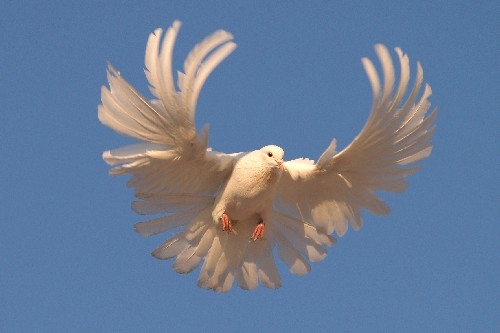
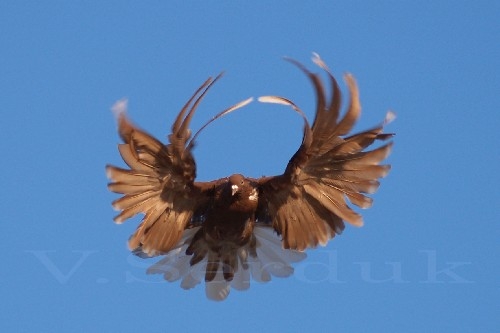
photos by Mr. V. Serduk of the Ukraine

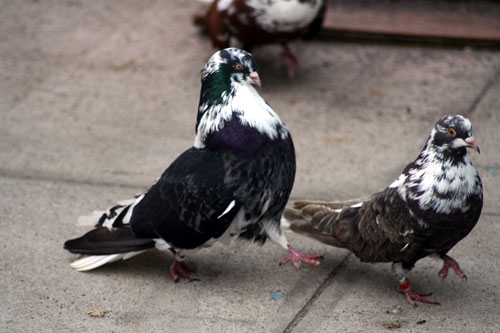
photos by Mr. E. Bogomolskiy of Brooklyn, NY.
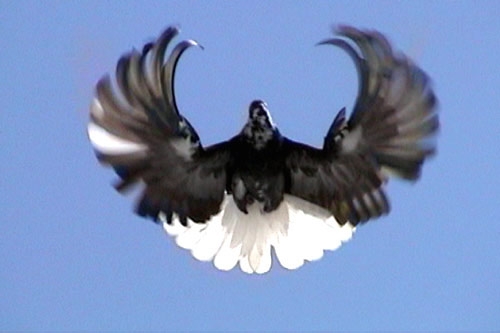
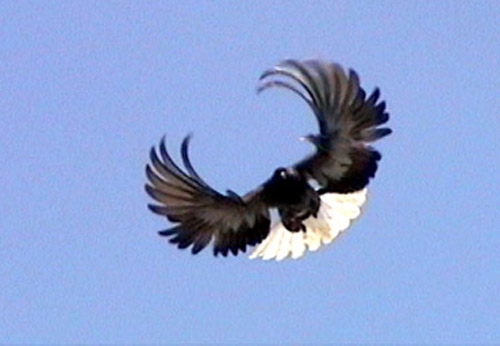
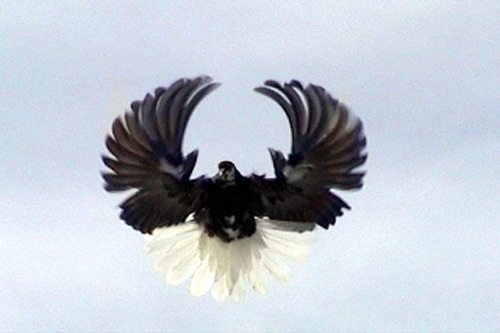
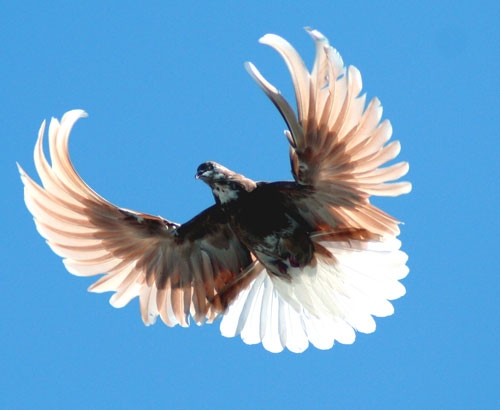
photos by Mr. Grigoriy Zilberg of N Brunswick, NY.